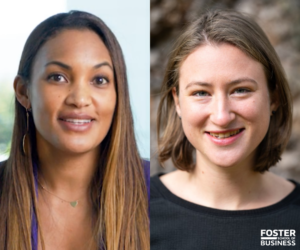From Foster to the World’s Most Admired Company: Three Takeaways on Inclusive Design
Design in its strictest form is inclusive and makes everyone feel valued. Made obvious by the emergence of terms like ‘inclusive design’ and ‘accessibility features’, the designs we see in our society have strayed away from that.
Lisa Mirth, BBA ‘01, focuses on inclusive product design at a world-class consumer technology firm. Alana Strassfield, MBA ’22, spoke with Lisa to get her take on how individuals and businesses can make products that work for everyone.

Lisa Mirth, BBA ’01 and Alana Strassfield, MBA ’22
While on a flight to a design bootcamp, years into her professional career, Lisa panicked. She realized she would need support to go through this user experience course she was taking for work. Lisa had gone through high school and college concealing from most that she was legally blind, and graduated, despite the extra work. On this flight, Lisa realized that the strategy of silence and concealment wouldn’t work this time, she would need the support of others in this course to succeed. She took a courageous first step and for the first time, she introduced herself to a group of strangers, as legally blind. When Lisa received the support she needed, a switch flipped. She saw that removing barriers for people with diverse needs brought them into the fold. They could have the same experience and make worthy contributions as others, without crippling anxiety, frustration, and extra effort. It was a new world.
When I got on the phone with Lisa, I hardly knew the difference between inclusivity and accessibility. Lisa explained that inclusive design doesn’t single a user out as different. Accessibility may come in the form of a feature, providing a low-vision person with a separate and different experience for example. Inclusivity, however, focuses more on building the initial product to cater to a wide variety of experiences and not single out a particular group or perspective. Experiences could be geographic — is the text on a screen easy to see in the overcast skies of Seattle and under the scorching Saharan sun? Experiences can be based on age, is it easy to type on a product for those who are just forming dexterity, maybe a toddler, and those who may be losing it, maybe a grandparent.
While there’s endless to learn from Lisa, an expert in inclusive design, I wanted to share the three most compelling takeaways from our time together.
1. Inclusivity is a core design principle.
It emerges from the theory that if usability is broken, even for a single person, the product doesn’t work.
2. Let people speak for themselves and do so by hiring diversely.
It’s essential to have people with disabilities working in your organization. Rather than having an able-bodied product manager speak to what they think is the experience of a disabled person, have people with various abilities and needs contribute to the design process that caters to their individual experiences. This is how people turn what’s perceived as a weakness into their strength. When people share their stories, they share perspective and information that’s invaluable to others.
3. Have the courage to connect with people outside of your comfort zone and double down on empathy.
It’s 2022 and we know that there’s always more to learn, always another perspective to seek to understand whether it’s that of race, sexual orientation, age and so on. What’s most important in pursuing this necessary endeavor of perspective-sharing is to open lines of communication. The worst thing we can do is turn our cheek because we don’t want to offend someone or say because we’re afraid of saying the wrong thing. Start somewhere, take the first step. Index on empathy more than sympathy and don’t be afraid to be uncomfortable.
Design in its strictest form is inclusive and makes everyone feel valued. Made obvious by the emergence of terms like ‘inclusive design’ and ‘accessibility features’, the designs we see in our society have strayed away from that. Just as those strangers in Lisa’s design bootcamp played a role in lifting barriers that would have prevented her participation, you can begin lifting barriers for others simply by starting a conversation and gaining perspective from someone you ordinarily might not speak to.
Lisa recently moved to the Bay Area for a new role focusing on inclusive product design. When she thinks about her alma matter, she appreciates that individuals she’s been able to connect with who also work in inclusivity. Someday, she hopes to work with UW on improving its design around inclusivity
